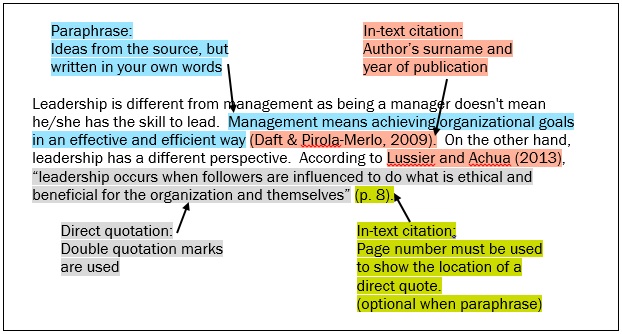
In-text citations appear in the body of your assignment.
You must include an in-text citation when using text (quote or paraphrasing) or visual content (image, chart or table) that has been taken from another source.
The citation should include:
Author's surname*
Year of publication
Page number**
*If there is no author or organisation name, please refer to more citation formats.
**When quoting, page numbers must be included where available. When paraphrasing, you do not need to include the page number; however it is encouraged, as it assists others to find the information that is referenced.
Citations can be positioned in the text as follows:
At the start of the sentence
e.g. Bond (2015) states...
At the end of the sentence
e.g. The results in the study were not conclusive (Bond, 2015).
Avoid undercitation and overcitation:
Undercitation: Ensure all sources of information or works referred to are given credit using an in-text citation.
Overcitation: Do not repeat the same citation throughout a paragraph where the source and topic are unchanged. Cite the source in the first sentence in which it is relevant and do not repeat the citation in subsequent sentences.
e.g. ... was concluded by the study (Hamburg & Schulz, 2022). The results centred around the link between the participants and their experiences and outlined justification for the program's continuation. In addition, the positive relationships built between groups A and B were noted and are to be further investigated in the coming months.
In-text citations are normally included in the word count unless otherwise specified in your assessment submission guidelines.
Speak to your teacher regarding assessment submission requirements.

|
Paraphrase |
Quote |
Author |
First citation |
2nd citation onwards |
Notes |
1 author |
(Bond, 2015) OR Bond (2015) |
See: first citation. |
|
2 authors |
(Tsukino & Shields, 2014) OR Tsukino and Shields (2014) |
See: first citation. |
|
3 or more authors |
(Potter et al., 2015) OR Potter et al. (2015) |
See: first citation. |
All citations:
|
Organisation/Corporate
|
(Austin Health, 2016) OR Austin Health (2016) |
See: first citation. |
Includes:
|
Organisation/Corporate
|
(Australian Bureau of Statistics [ABS], 2024) OR Australian Bureau of Statistics [ABS] (2024) |
(ABS, 2024) OR ABS (2024) |
First citation:
2nd citation onwards:
|
As cited in (secondary source) |
(O'Reilly, 1998, as cited in Byrne, 2008) OR O'Reilly (1998, as cited in Byrne, 2008) |
See: first citation. | Used to cite a reference mentioned in another source. |
Hyphenated names |
|
Editor |
|
No author |
|
No date |
|
No page numbers (quotes) |
|
Discontinuous page numbers from same source |
|
Multiple authors with the same surname |
|
Multiple citations in one reference |
|
Multiple works by the same author with the same date |
|
Multiple works by the same author with no date |
|
Quotes are text that is repeated or copied from text written by another person, with the exact same wording, punctuation and spelling.
Paraphrasing is when you use your own words to express someone else's ideas, or to summarise their research.
When paraphrasing, you do not need to include the page number; however it is encouraged, as it assists others to find the information that is referenced.

Brief quotes are less than 40 words. Refer to Quotes above for format.
Longer quotes are 40 words or more. Format as a block quote, as explained below:
Example of a longer quote:
The study by Preston and Logan (2014) showed that
this is the quote here. It started in lowercase because it is continuing on from the sentence above. The quote goes for at least 40 words. The paragraph can continue after this block quote; just continue with the text aligned on the left margin, in line with the sentence that introduced this quote. This quote then stands out, indented on its own (p. 78).